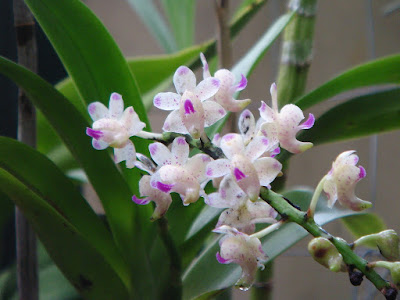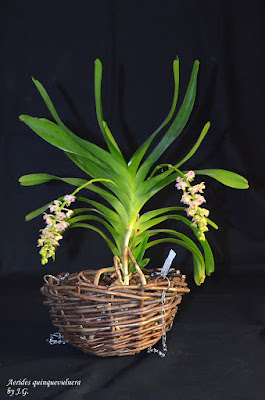Aerides quinquevulnera is a native of Mindanao (Philippine Islands), Sumatra, Borneo and Timor. It grows upon tall trees at elevations of 300 to 2000 meters above sea level.
Aerides quinquevulnera also called as The Aerides with 5 wounds, Aerides album, Aerides farmeri, Aerides fenzlianum, Aerides maculatum, Aerides marginatum, Aerides quinquevulnera f. farmeri, Aerides quinquevulnera f. flava, Aerides quinquevulnera f. punctata, Aerides quinquevulnera var farmeri, Aerides quinquevulnera var flava, Aerides quinquevulnera var marginata, Aerides quinquevulverna var punctata, Aerides quinquevulnera var purpurata, Aerides quinquevulnera var schadenbergiana, is a species of the genus Aerides. This species was described by John Lindley in 1833.
IDENTIFY AERIDES QUINQUEVULNERA ORCHID PLANT
Aerides quinquevulnera is a native of Mindanao (Philippine Islands), Sumatra, Borneo and Timor. It grows upon tall trees at elevations of 300 to 2000 meters above sea level.
It is a large sized, hot to cool growing monopodial epiphyte that has lorate, leathery leaves that are apically bilobed. The plant somewhat like Aerides odoratum in appearance, but is distinguishable by the habit of its leaves in clasping the stem of the plant.
The Aerides with 5 wounds blooms at most any time of the year on a densely many flowered, 45 cm long, sharply pendulous inflorescence with fragrant, long-lasting, waxy flowers. The flowers also resemble those of Aerides odoratum but are distinguishable by five reddish-crimson blotches on the sepals and petals, from which it gets its name. Lip is funnel-shaped, and the spur is green in colour and conical in shape. The flowers are sweetly perfumed, their scent resembling that of "Lily-of-the-Valley".
AERIDES QUINQUEVULNERA ORCHID PLANT CARE AND CULTURE
Cultural information should only be used as a guide, and should be to be adapted to suit you. Your physical location; where you grow your plants, how much time you have to devote to their care, and many other factors, will need to be taken into account. Only then can you decide on the cultural methods that best suit you and your plants.
Light:
Aerides quinquevulnera loves bright sunlight and is able to safely carry direct sunlight (up to 50000 Lux). The total duration of daylight hours must be at least 10 hours.
Temperature:
The climatic conditions in their habitat are somewhat similar, i.e., on the coastline the temperature never falls below 20°C nor rises above 33°C. At the elevation at which their native growth takes place the mean average range of temperature would be from approximately 14-25°C. For successful cultivation at home, it is necessary that the night temperature always be at least 3-4 ° C lower than the daytime. Cool night maintenance is one of the important factors that stimulate its flowering.
Humidity:
The Aerides with 5 wounds need the humidity level of 70% .Too dry air has a negative effect on the development of the plant: its growth is inhibited, and the leaves begin to turn yellow and dry out. The higher temperature, the higher the humidity should be, and the higher the humidity, the more often and longer it is necessary to ventilate the room where the plants are contained, otherwise the probability of rotting and various kinds of fungal diseases.
Substrate, growing media and repotting:
Aerides quinquevulnera are grown in pot or basket with a mixture of large pieces of charcoal and crocks from the top of the pot or basket, with a layer of sphagnum moss on the surface. The addition of peat or fibre and also of large pieces of well dried cow-dung are satisfactory variations.
They are also be grown on blocks or rafts. This method of treatment would allow of abundant watering at the right seasons without risk of damage-in any case, the drainage of any container must be free.
It is no need for frequent repot, therefore, it is desirable to transplant only when it is really necessary, for example, in cases of severe salinization or compaction of the substrate, at its critically high or low pH (rate from 5.5 to 6.5). The best time to transplant is a period of active root growth.
Watering:
Watering is directly dependent on the temperature of the content, the higher it is, the more often it needs to be watered. Plants growing on blocks or with a bare root system, preferably watered daily in the morning, so that in the evening their roots can dry out relatively well. During the summer heat, additional spraying is possible. When watering, excess water should flow freely from the pot, since stagnation of water both inside the pot and in its pan can very quickly lead to rotting of the roots and the lower part of the plant. The substrate between waterings should dry well.
Fertilizer:
During the period of active growth fertilize this type of orchid once a month with 1/4 of the concentration of fertilizer indicated on the package. Their roots are very sensitive to various types of potash, phosphorus, etc. salts contained in the fertilizer, and can deteriorate very quickly. The most sensitive place of the root is its tip, which under the effect of too concentrated fertilizer turns black and dries. In addition to the usual root dressing, it is also recommended to produce foliar, when the outer part of the plant is sprayed with very diluted fertilizer. It is best to feed the orchid, alternating between these two methods. The best fertilizer is fertilizer containing nitrogen, phosphorus and potassium in equal shares, for example, NPK = 3-3-3 or 8-8-8. If you do not have such fertilizer, then at the beginning of the growing season, feed the orchid with fertilizer with a high nitrogen content, and when the leaves reach 1/2 of its normal size, fertilizer with a higher phosphorus content.
Rest period:
Aerides quinquevulnera don't need a rest period but need less water in the winter, especially if they grow under the conditions of a dark, short day that occurs at moderate latitudes. They should dry somewhat between waterings, but they should not be dry for a longer period. Fertilization should be reduced or eliminated until new growths appear and a more abundant spring watering begins.















COMMENTS